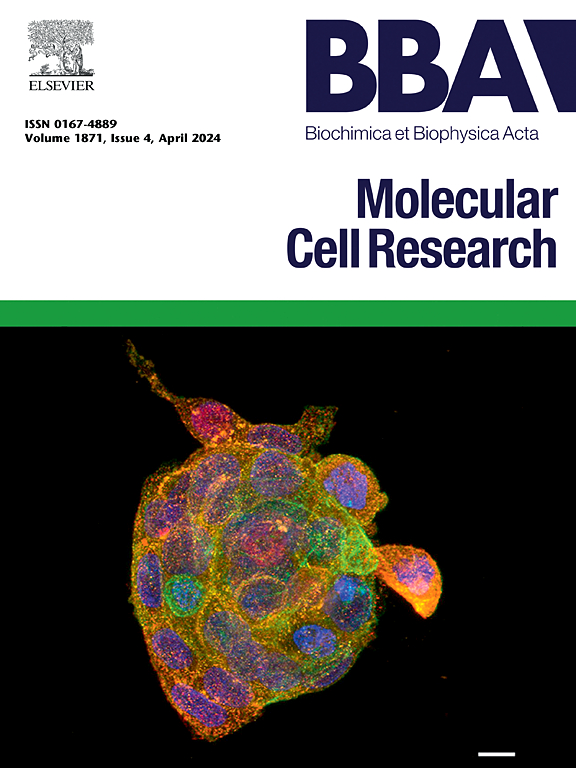RIPK3 activation promotes peritoneal dialysis-related peritoneal fibrosis via NLRP3/Caspase-1/IL-1β pathway
IF 3.7
2区 生物学
Q1 BIOCHEMISTRY & MOLECULAR BIOLOGY
Biochimica et biophysica acta. Molecular cell research
Pub Date : 2025-09-13
DOI:10.1016/j.bbamcr.2025.120060
引用次数: 0
Abstract
Peritoneal fibrosis is one of the leading causes for withdraw of peritoneal dialysis (PD) but there is no available effective therapy strategy. As an essential role in regulating TNF-induced necroptosis, receptor interacting protein kinase-3 (RIPK3) participated in the progression of multiple organ fibrosis. Here, we investigated the role and the possible mechanism of RIPK3 in PD-associated peritoneal fibrosis in PD patients, a mouse peritoneal dialysis model and in vitro peritoneal mesothelial cells. We found that phosphorylated-RIPK3 (p-RIPK3) were markedly elevated in PD fluids and peritoneal tissue from PD patients, a mouse PD model and in peritoneal mesothelial cells induced by TGFβ and high glucose PD fluids. And activated RIPK3 recruits its substrate protein, MLKL, and promotes its phosphorylation. RIPK3 kinase inhibition using GSK’872 compound could attenuate high glucose PD fluid-induced peritoneal fibrosis in a mouse PD model. In vitro peritoneal mesothelial cells, RIPK3 kinase inhibition or siRNA transfection target on RIPK3 attenuate TGFβ or high glucose PD fluid-induced fibrotic progress. Meanwhile, GSK’872 intervention could inhibit the NLRP3/Caspase-1/IL-1β pathway in PD mouse model and in vitro peritoneal mesothelial cells, inhibiting RIPK3 kinase activity or siRNA silencing RIPK3 expression could block NLRP3/Caspase-1/IL-1β pathway. Moreover, Co-immunoprecipitation (Co-IP) experiment and immunofluorescence indicated that p-RIPK3 could combinate with NLRP3 and TGFβ intervention could promote this interaction, while RIPK3 kinase inhibitor could avianize their combination. These findings implicate that RIPK3 activation may be a crucial mediator in PD associated peritoneal fibrosis and targeting RIPK3 activation may be a novel therapeutic strategy to attenuate PD-related peritoneal fibrosis.
RIPK3激活通过NLRP3/Caspase-1/IL-1β途径促进腹膜透析相关的腹膜纤维化。
腹膜纤维化是腹膜透析(PD)退出的主要原因之一,但目前还没有有效的治疗策略。受体相互作用蛋白激酶3 (receptor interacting protein kinase-3, RIPK3)在调节tnf诱导的坏死性坏死中起重要作用,参与了多器官纤维化的进展。在这里,我们研究了RIPK3在PD患者、小鼠腹膜透析模型和体外腹膜间皮细胞中PD相关腹膜纤维化的作用和可能的机制。我们发现磷酸化ripk3 (p-RIPK3)在PD患者、小鼠PD模型的PD液和腹膜组织以及TGFβ和高糖PD液诱导的腹膜间皮细胞中显著升高。激活的RIPK3招募其底物蛋白MLKL,并促进其磷酸化。使用GSK'872化合物抑制RIPK3激酶可减轻高糖PD液诱导的小鼠PD模型腹膜纤维化。在体外腹膜间皮细胞中,RIPK3激酶抑制或siRNA转染靶向RIPK3可减弱TGFβ或高糖PD液诱导的纤维化进展。同时,GSK'872干预可抑制PD小鼠模型及体外腹膜间皮细胞NLRP3/Caspase-1/IL-1β通路,抑制RIPK3激酶活性或siRNA沉默RIPK3表达可阻断NLRP3/Caspase-1/IL-1β通路。此外,共免疫沉淀(Co-IP)实验和免疫荧光实验表明,p-RIPK3可以与NLRP3结合,TGFβ干预可以促进这种相互作用,而RIPK3激酶抑制剂可以使它们的结合无鸟化。这些发现表明,RIPK3激活可能是PD相关腹膜纤维化的关键介质,靶向RIPK3激活可能是减轻PD相关腹膜纤维化的一种新的治疗策略。
本文章由计算机程序翻译,如有差异,请以英文原文为准。
求助全文
约1分钟内获得全文
求助全文
来源期刊
CiteScore
10.00
自引率
2.00%
发文量
151
审稿时长
44 days
期刊介绍:
BBA Molecular Cell Research focuses on understanding the mechanisms of cellular processes at the molecular level. These include aspects of cellular signaling, signal transduction, cell cycle, apoptosis, intracellular trafficking, secretory and endocytic pathways, biogenesis of cell organelles, cytoskeletal structures, cellular interactions, cell/tissue differentiation and cellular enzymology. Also included are studies at the interface between Cell Biology and Biophysics which apply for example novel imaging methods for characterizing cellular processes.

 求助内容:
求助内容: 应助结果提醒方式:
应助结果提醒方式:


